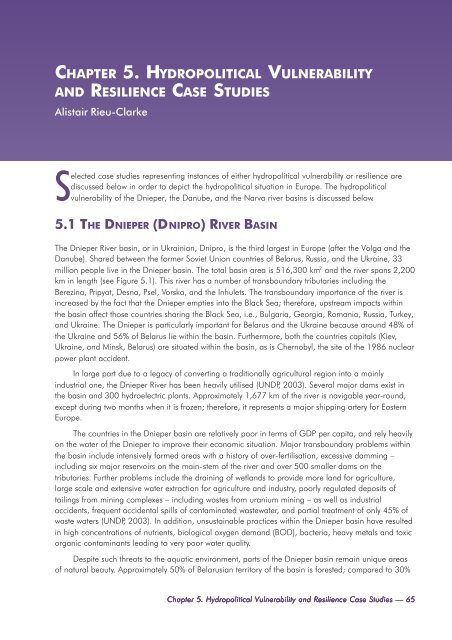Europe - UNEP
Europe - UNEP
Europe - UNEP
You also want an ePaper? Increase the reach of your titles
YUMPU automatically turns print PDFs into web optimized ePapers that Google loves.
CHAPTER 5. HYDROPOLITICAL VULNERABILITY<br />
AND RESILIENCE CASE STUDIES<br />
Alistair Rieu-Clarke<br />
Selected case studies representing instances of either hydropolitical vulnerability or resilience are<br />
discussed below in order to depict the hydropolitical situation in <strong>Europe</strong>. The hydropolitical<br />
vulnerability of the Dnieper, the Danube, and the Narva river basins is discussed below.<br />
5.1 THE DNIEPER (DNIPRO) RIVER BASIN<br />
The Dnieper River basin, or in Ukrainian, Dnipro, is the third largest in <strong>Europe</strong> (after the Volga and the<br />
Danube). Shared between the former Soviet Union countries of Belarus, Russia, and the Ukraine, 33<br />
million people live in the Dnieper basin. The total basin area is 516,300 km 2 and the river spans 2,200<br />
km in length (see Figure 5.1). This river has a number of transboundary tributaries including the<br />
Berezina, Pripyat, Desna, Psel, Vorska, and the Inhulets. The transboundary importance of the river is<br />
increased by the fact that the Dnieper empties into the Black Sea; therefore, upstream impacts within<br />
the basin affect those countries sharing the Black Sea, i.e., Bulgaria, Georgia, Romania, Russia, Turkey,<br />
and Ukraine. The Dnieper is particularly important for Belarus and the Ukraine because around 48% of<br />
the Ukraine and 56% of Belarus lie within the basin. Furthermore, both the countries capitals (Kiev,<br />
Ukraine, and Minsk, Belarus) are situated within the basin, as is Chernobyl, the site of the 1986 nuclear<br />
power plant accident.<br />
In large part due to a legacy of converting a traditionally agricultural region into a mainly<br />
industrial one, the Dnieper River has been heavily utilised (UNDP, 2003). Several major dams exist in<br />
the basin and 300 hydroelectric plants. Approximately 1,677 km of the river is navigable year-round,<br />
except during two months when it is frozen; therefore, it represents a major shipping artery for Eastern<br />
<strong>Europe</strong>.<br />
The countries in the Dnieper basin are relatively poor in terms of GDP per capita, and rely heavily<br />
on the water of the Dnieper to improve their economic situation. Major transboundary problems within<br />
the basin include intensively farmed areas with a history of over-fertilisation, excessive damming –<br />
including six major reservoirs on the main-stem of the river and over 500 smaller dams on the<br />
tributaries. Further problems include the draining of wetlands to provide more land for agriculture,<br />
large scale and extensive water extraction for agriculture and industry, poorly regulated deposits of<br />
tailings from mining complexes – including wastes from uranium mining – as well as industrial<br />
accidents, frequent accidental spills of contaminated wastewater, and partial treatment of only 45% of<br />
waste waters (UNDP, 2003). In addition, unsustainable practices within the Dnieper basin have resulted<br />
in high concentrations of nutrients, biological oxygen demand (BOD), bacteria, heavy metals and toxic<br />
organic contaminants leading to very poor water quality.<br />
Despite such threats to the aquatic environment, parts of the Dnieper basin remain unique areas<br />
of natural beauty. Approximately 50% of Belarusian territory of the basin is forested; compared to 30%<br />
Chapter 5. Hydropolitical Vulnerability and Resilience Case Studies — 65
















